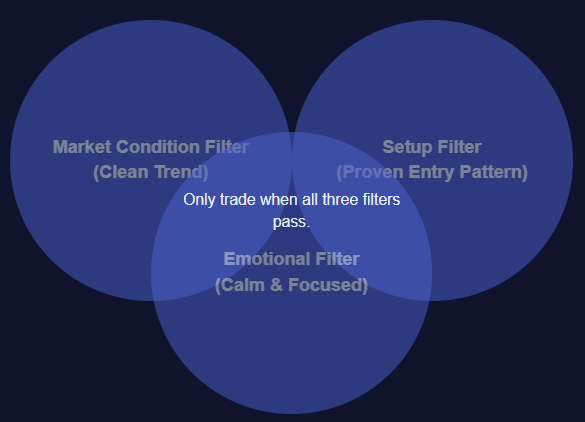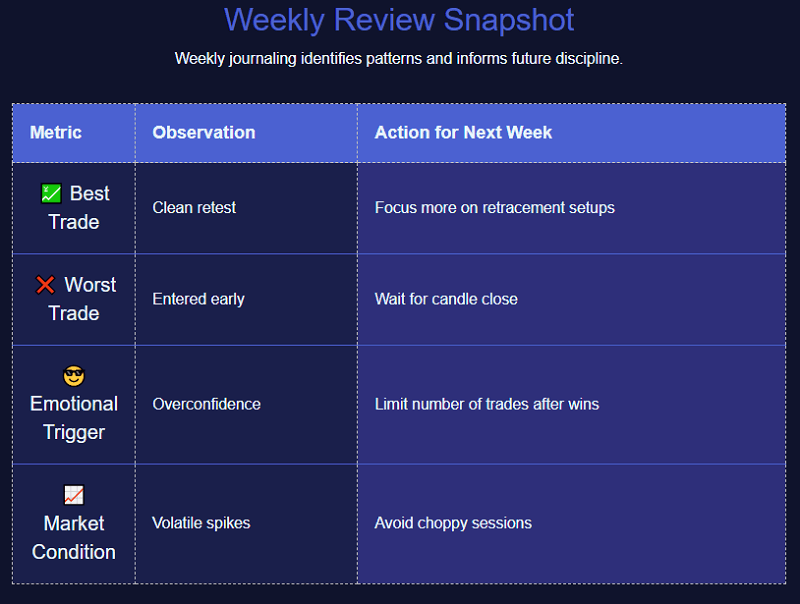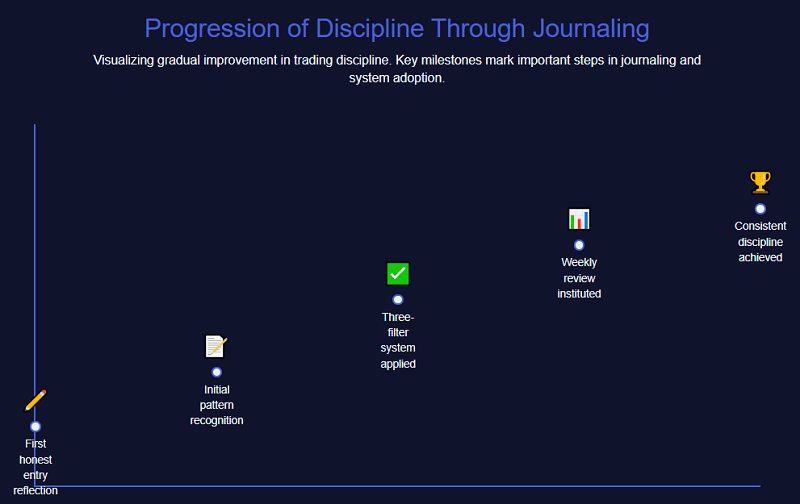How I Built True Trading Discipline Through a Binary Options Trading Journal

From the moment I placed my first binary options trade, I told myself I was disciplined. I repeated it like a mantra: “I follow rules. I wait for setups. I stay in control.” It took me losing multiple small accounts to finally admit that I wasn’t half as disciplined as I believed. I had flashes of discipline, not a system. And flashes don’t survive real markets. The shift only happened the day I wrote down my trades instead of simply remembering them. That first journal page became the start of a long learning curve, full of frustration, surprising discoveries, and a kind of honesty I had been avoiding for years.
If you want to follow the same approach while practicing in a stable environment, it helps to trade inside a proper platform where you can observe your habits without risking too much too soon. I began shaping my discipline using both demo and small live accounts. You can open an account here to develop your own habits while reading through this guide.
Let me take you through my journey, how a simple notebook reshaped the kind of trader I became, and how a binary options trading journal became the tool that finally taught me real discipline.
When I Realized My Discipline Was Only an Illusion
The moment discipline became more than a word for me was the first time I reviewed my trade history after a chaotic week. I saw losses scattered everywhere, entries that made no logical sense, and trades I didn’t even remember placing. I noticed how many of those trades came from impulses I never acknowledged at the time. What bothered me most wasn’t the losses, but the fact that I couldn’t justify them. If I didn’t know why I placed a trade, how could I expect to improve anything?
That week was filled with moments where I made decisions simply because the charts “felt right.” I entered because the candles looked energetic, because I thought I saw momentum, or because I didn’t want to “miss the move.” Those reasons sound embarrassing to admit, but that embarrassment was the push that made me open a notebook and write down exactly what I was thinking whenever I clicked “buy” or “sell.”
That’s when the discipline transformation truly started.
How I Built a Practical Journal Structure That Made Learning Possible
My journal didn’t start as a perfect system. I added pages, removed pages, changed formats, and slowly realized that discipline doesn’t come from making a beautiful notebook. It comes from recording the parts of trading we normally hide from ourselves.
The basic structure that emerged looked like this:
| Section | Purpose | What It Showed Me |
| Market Conditions | To avoid trading unpredictable sessions | My worst trades happened in choppy environments |
| Setup Description | To confirm whether I actually had an entry | Almost half my old trades had no valid setup behind them |
| Emotional State | To identify triggers | Fatigue, excitement, and revenge led to most bad decisions |
| Timing | To see which sessions fit me | I traded best during early London hours |
| Post-Trade Notes | To extract lessons | The same mistakes repeated until I wrote them down |
This table became the backbone of my discipline, because now every decision had a place to be examined.
The Slow, Uncomfortable Process of Tracking My Own Mistakes
In the first two weeks of journaling, I noticed something that hit me hard: the majority of my losses had little to do with strategy and everything to do with impulse. Writing down my emotional state before each trade exposed patterns I didn’t know existed. I saw that I traded more aggressively when coming off a win. I saw that I rushed entries when I felt behind for the day. I saw that boredom made me place trades that had no business being on my chart.
Discipline wasn’t something I could “summon” when needed. It was something I had to train like a muscle, and this journal forced me to face the reps I had skipped for years.
How Daily Journaling Shaped a Routine That Brought Structure to My Trading
A turning point came when journaling became part of my daily rhythm instead of something I did only when I felt like it. I created a four-part routine that guided my thinking before, during, and after my trading sessions. Over time, this routine made me calmer, more patient, and far more selective.

1. My Pre-Market Review Made Me More Intentional
Before trading, I wrote a small overview describing how the market looked, clean trends, ranging phases, or confused movement. I also included how I felt mentally. If I was tired, stressed, or distracted, I adjusted my expectations. This short exercise prevented me from forcing trades during bad market conditions and made me more selective before I even opened the chart.
2. My During-Trade Notes Kept Me Grounded
While a trade was active, I wrote one or two lines describing why I entered. Not big paragraphs, just simple reminders like “level rejection matches rule” or “feels rushed, not confident.” Writing these thoughts mid-trade slowed my emotions and kept me aligned with my plan.
3. My Post-Trade Reflections Created Accountability
Every time I closed a trade, I wrote whether the entry was valid and which emotions influenced me. Sometimes the trade was profitable but technically invalid. Sometimes it was a loss but a perfect decision. The journal taught me to judge my trades based on rules, not outcomes.
4. My End-of-Day Summary Developed Self-Awareness
At the end of each session, I summarized what I learned. I paid attention to market conditions, emotional patterns, and repeated mistakes. These small reflections helped me recognize triggers that disrupted discipline. Over time, I noticed consistent themes: I performed worse when tired, I struggled during ranging markets, and I became overconfident after three consecutive wins.
This entire practice taught me something crucial: discipline grows through small, repetitive habits, not through big promises.
The Journal Entries That Permanently Changed How I Trade
Some of the most powerful lessons came from short, brutally honest sentences I didn’t enjoy writing at the time.
Entry example:
“When I enter before the candle closes, it’s not confidence. It’s impatience pretending to be timing.”
Another entry said:
“I took this trade because I didn’t want to wait. That isn’t a setup. That’s boredom wearing a strategy’s mask.”
The most painful entry in my early journal was this one:
“I tried to win back my loss, not analyze the chart.”
Seeing these statements in my handwriting felt uncomfortable, but that discomfort built discipline faster than any indicator or strategy could. It forced me to take responsibility for every decision instead of blaming the market.
Why Tracking Emotions Became More Important Than Tracking Indicators
Indicators never told me that I performed poorly when hungry, that I rushed trades when short on time, or that my confidence dropped on Friday evenings. Only journaling revealed these patterns. It made me realize that discipline isn’t about trading signals, it’s about emotional clarity.
To deepen that clarity, I also began studying market structure more seriously. This included returning to foundational concepts like support and resistance trading, which helped me see cleaner entry points and reduced the impulsive decisions that emotion often triggered. I wrote about these setups as I practiced them, and the consistency improved my discipline naturally.

Building My Three-Filter Discipline System From Repeated Journal Insights
Over many months, I noticed a recurring theme: my best trades passed through three layers of confirmation, not just one. I eventually turned these observations into a simple system that filtered out emotional or low-quality trades.

Filter 1: Market Conditions Must Be Clear
If the chart was messy, I stayed out. No exceptions.
Filter 2: Setup Must Match One of My Proven Patterns
I stopped inventing new setups on the spot. The journal made my successful patterns obvious.
Filter 3: My Emotional State Must Be Stable Enough to Trade
If I felt rushed, frustrated, or restless, I closed the platform.
This three-filter rule saved me from dozens of unnecessary trades, especially during volatile periods. Ironically, this rule came not from strategy research but from documenting my own behavior.
Why a Binary Options Trading Journal Surpassed Indicators in Improving My Discipline
Indicators help with timing. Journaling helps with decision-making. The difference is significant. When I documented my decisions, I couldn’t hide behind indicators anymore. I had to admit when I placed trades because of fear, greed, or boredom.
Linking my observations to broader trading principles helped as well. Reading more about money management rules most beginners ignore reinforced everything my journal taught me about discipline. It made me understand that risk control isn’t a separate topic, it’s woven into every trade decision.
I also began paying more attention to psychological topics, especially greed. One article that resonated with my experiences was about why greed destroys more binary accounts than strategy mistakes. I saw that pattern clearly in my journal: my worst trading days didn’t come from bad strategy but from emotional excess. Recognizing that connection made discipline feel less like a restriction and more like a safeguard.
Bringing Structure to My Notes With a Simple Weekly Review Ritual
The weekly summary became the part of my journal that genuinely accelerated my growth. Sundays became my review day. I scanned through the week and highlighted my strongest trades, my weakest ones, the sessions I handled well, and the moments where emotions overpowered logic. These reviews helped me refine my trading plan in a patient, deliberate way.
A memorable weekly summary of mine pointed out that my best trades occurred during clean retests and that most of my failed trades took place when I anticipated breakouts. That single discovery reshaped my strategy and made my trading more selective.
During these reviews, I also studied tutorials on core market concepts to refine my skills. For example, learning how price respects support and resistance levels helped me see the logic behind market reactions I previously ignored. Combining journal insights with foundational learning created a powerful loop of improvement.
How My Binary Options Trading Journal Shifted My Mindset Toward Patience
In the beginning, my trading lacked patience. I wanted constant action, constant entries, constant confirmation that I was “in the game.” Once I started documenting trades, patience started growing without me forcing it. I realized how many losses came from entering early or refusing to sit on my hands during low-quality conditions.
Writing down the reasons behind each trade made low-quality setups feel unattractive. The journal turned impatience into something I could spot and correct rather than something I fell into unconsciously.

How Beginners Can Start Journaling Without Feeling Overwhelmed
If someone is just starting out, I always recommend beginning with just four simple details per trade: the reason for entering, emotional state, trade result, and takeaway. Nothing more. You can expand later once consistency forms. The important thing is to begin, not to create a perfect format on day one.
For those who want deeper structure, you can gradually include more information, such as time of day, specific patterns, or notes about market structure. This is where referencing materials like Fibonacci retracements or foundational articles on reading support and resistance can deepen the quality of your notes. But that depth only becomes helpful once the basic habit is in place.
Why Advanced Traders Benefit Even More From Journaling
Experienced traders often assume they know themselves well, but journaling exposes blind spots even at advanced levels. It reveals tendencies you overlook, such as taking too many trades on trendless days or trading at times that don’t fit your rhythm. Many advanced traders have strong strategies but weak discipline. The journal bridges that gap.
When I documented the differences between my structured trades and the ones I took out of impulse, the contrast was dramatic. It made me refine my system, reduce unnecessary entries, and focus on clean structure-based setups. This is where studying topics like surviving losing streaks helped me understand why traders fall apart under pressure and how consistency in journaling prevents emotional spirals.
If you want to practice the exact routines and discipline-building habits I’m describing, doing it in a real trading interface helps you form consistent behavior. You can open an account here and apply your journal-building habits in real market conditions at your own pace.
How My Journal Led Me Toward a More Repeatable, Long-Term Trading System
Over months of honest documentation, patterns began to emerge, patterns that shaped my long-term system. I learned which sessions suited me, which pairs I handled best, and which setups had the highest consistency for my personality. I realized I performed far better in steady trends than in sudden spikes. I saw that I preferred reversal setups over continuation plays.
None of these insights came from a course or a mentor. They came from observing myself through my journal.

Ending My Day With a Final Reflection Strengthened Long-Term Discipline
Toward the end of my journey, I added one more habit: writing a final sentence that summarized the entire trading day. It might be something like: “Patience kept me safe today” or “I rushed the second trade and paid for it” or “Today was clean, calm, and within rules.” These simple closing statements helped anchor my mindset and reinforced the identity of a disciplined trader.
If you want to start this journey and build discipline through your own binary options trading journal, the best way is to begin practicing inside a structured trading environment. You can open an account here and apply the same habits that transformed my trading approach.
Final Thoughts
Looking back, I thought discipline was something I could “will” into existence. I tried forcing it through strict rules, short-term challenges, and motivational quotes. None of it lasted. Real discipline came from documenting my actions, confronting them, and learning from them. A binary options trading journal became my mirror, sometimes harsh, always truthful, and ultimately transformative.
If you stay consistent with your journal, discipline will grow naturally. It won’t be easy, but it will be real. And once discipline becomes part of who you are as a trader, everything else, strategy, confidence, results begins to align.